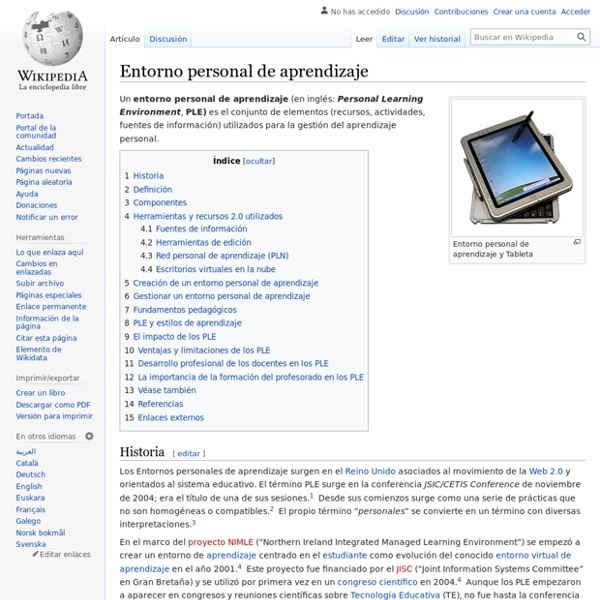



https://es.wikipedia.org/wiki/Entorno_personal_de_aprendizaje
Related: PLE (Entorno personal aprendizadje) • PLE-PLN • DIDACTICAS DIGITALESWhat is Personalized Learning? – Personalizing the Learning Experience: Insights from Future Ready Schools – Medium In the past if you’d seen one definition of personalized learning, you’d seen… well… one definition of personalized learning. While this is a common occurrence in the early stages of disruptive innovation in any field, the lack of a consistent definition and language for a relatively complex idea has hampered both understanding and effective implementation. The situation was further complicated by the use of several terms interchangeably with personalized learning, most notably: adaptive learning, blended learning, competency-based learning, differentiated learning, and individualized learning. Today, however, most in the education community would agree that while each of these learning approaches shares attributes with personalized learning, none is synonymous.
Building your PLN Skip to content Building your PLN Know it or not, you already have some sort of Personal Learning Network or PLN! It could be your colleagues, family, students, friends – whoever! But with the power of the web and online collaboration – a PLN could really grow! This series guides you step by step through the process of building your PLN.
Questia After many years of successfully serving the needs of our customers, HighBeam Research has been retired. Because HighBeam Research has closed down we have taken you to our sister website Questia, an award-winning Cengage Learning product. Located in downtown Chicago, Questia is the premier online research and paper writing resource. Since its founding in 1998, Questia has helped students find and cite high-quality, scholarly research. With emphasis on subjects related to the humanities and social sciences, Questia provides the resources needed to complete most college-level, core-curriculum course assignments.
10 Rompehielos Techy para el maestro del siglo 21 ~ Tecnología Educativa y Aprendizaje Móvil Here are some great icebreakers you can work on using technology : 1- Self PortraitHave your students draw themselves. After they have done this, collect the papers and hang them up for the whole class to see. Now have students try to guess who the artists was for each picture. Here are the web tools to do that :
Personalized Learning Definition The term personalized learning, or personalization, refers to a diverse variety of educational programs, learning experiences, instructional approaches, and academic-support strategies that are intended to address the distinct learning needs, interests, aspirations, or cultural backgrounds of individual students. Personalized learning is generally seen as an alternative to so-called “one-size-fits-all” approaches to schooling in which teachers may, for example, provide all students in a given course with the same type of instruction, the same assignments, and the same assessments with little variation or modification from student to student. Personalized learning may also be called student-centered learning, since the general goal is to make individual learning needs the primary consideration in important educational and instructional decisions, rather than what might be preferred, more convenient, or logistically easier for teachers and schools. Debate
Personal Knowledge Mastery seek > sense > share PKM is a unified framework of individually constructed enabling processes to help each of us make sense of our world, work more effectively, and contribute to society. PKM means taking control of your professional development, and staying connected in the network era, whether you are an employee, self-employed, or between jobs. Personal – according to one’s abilities, interests & motivation. (not directed by external forces)Knowledge – understanding information and experience in order to act upon it.
Descubra grandes artículos en profundidad sobre Google - Dentro de la búsqueda To understand a broad topic, sometimes you need more than a quick answer. Our research indicates perhaps 10% of people’s daily information needs fit this category -- topics like stem cell research, happiness, and love, to name just a few. That's why over the next few days we’ll be rolling out a new feature to help you find relevant in-depth articles in the main Google Search results. Now sometimes when you're searching for a broad topic (on google.com in English to start), you'll find a new block of results like the following: If you care about censorship, you'll find a thought-provoking article by Salman Rushdie in The New Yorker, a piece by our very own Eric Schmidt and Jared Cohen in the Guardian, and another great article about Iran. If you're in the mood for something lighter, search for [lego], you'll find great in-depth articles about many different facets of the topic from gender to engineering to art.
The 4 X 4 of Personalized Learning (Part 4) Part Four: It’s easy to think of personalized learning as just a buzzword and have trouble imagining it working in public schools But at Education Elements we know it’s actually both feasible and successful...and happening in school districts across the country. Over the past few months I have shared with you 4 promises, 4 facts and 4 approaches to personalized learning.
a network perspective The three overlapping circles of the network learning model – social networks, communities of practice, work teams – have been described by Patti Anklam as three network types – connectivity, alignment, productivity. This makes sense, because in social networks we mostly connect, while in communities of practice we strive to find alignment between ideas and practice, and in our work teams we produce something of value. Patti goes on to describe the key tasks for ‘network builders’. Connectivity Network (social network) – “Weaving — Helping people make connections, increase ease of sharing information”Alignment Network (community of practice) – “Facilitating — helping people to explore potential shared identity and value propositions”Productivity Network (work team) – “Coordinating — helping people plan and implement collaborative action” Perceiving all three of these spaces as networks reinforces the principle that we cannot manage networks, only influence through our interactions.